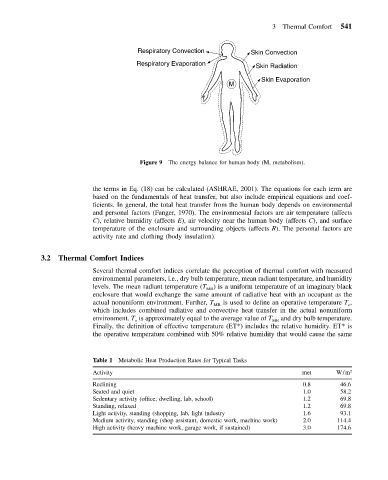Page 552 - Mechanical Engineers' Handbook (Volume 4)
P. 552
3 Thermal Comfort 541
Respiratory Convection Skin Convection
Respiratory Evaporation Skin Radiation
Skin Evaporation
M
Figure 9 The energy balance for human body (M, metabolism).
the terms in Eq. (18) can be calculated (ASHRAE, 2001). The equations for each term are
based on the fundamentals of heat transfer, but also include empirical equations and coef-
ficients. In general, the total heat transfer from the human body depends on environmental
and personal factors (Fanger, 1970). The environmental factors are air temperature (affects
C), relative humidity (affects E), air velocity near the human body (affects C), and surface
temperature of the enclosure and surrounding objects (affects R). The personal factors are
activity rate and clothing (body insulation).
3.2 Thermal Comfort Indices
Several thermal comfort indices correlate the perception of thermal comfort with measured
environmental parameters, i.e., dry bulb temperature, mean radiant temperature, and humidity
levels. The mean radiant temperature (T ) is a uniform temperature of an imaginary black
MR
enclosure that would exchange the same amount of radiative heat with an occupant as the
actual nonuniform environment. Further, T is used to define an operative temperature T ,
MR o
which includes combined radiative and convective heat transfer in the actual nonuniform
environment. T is approximately equal to the average value of T and dry bulb temperature.
o MR
Finally, the definition of effective temperature (ET*) includes the relative humidity. ET* is
the operative temperature combined with 50% relative humidity that would cause the same
Table 1 Metabolic Heat Production Rates for Typical Tasks
Activity met W/m 2
Reclining 0.8 46.6
Seated and quiet 1.0 58.2
Sedentary activity (office, dwelling, lab, school) 1.2 69.8
Standing, relaxed 1.2 69.8
Light activity, standing (shopping, lab, light industry 1.6 93.1
Medium activity, standing (shop assistant, domestic work, machine work) 2.0 114.4
High activity (heavy machine work, garage work, if sustained) 3.0 174.6

